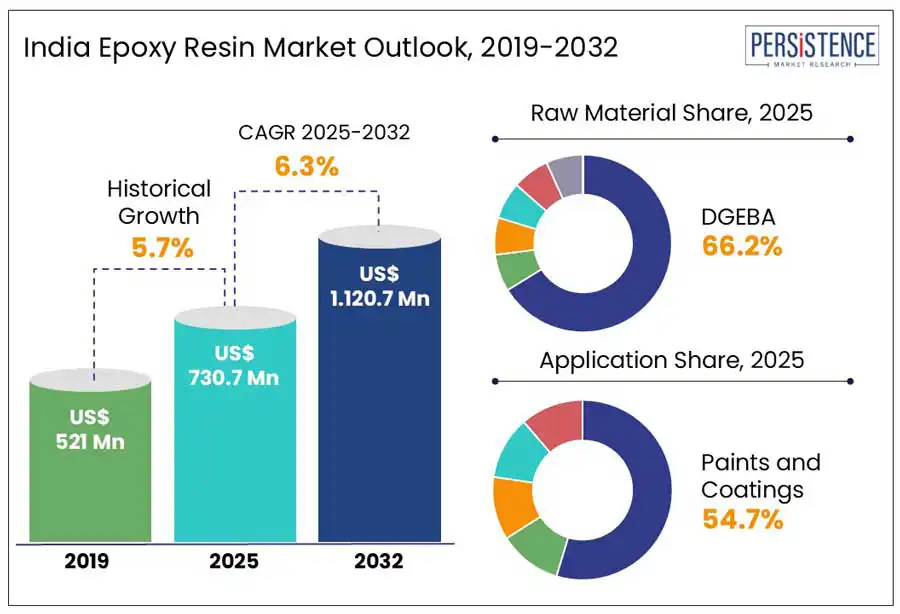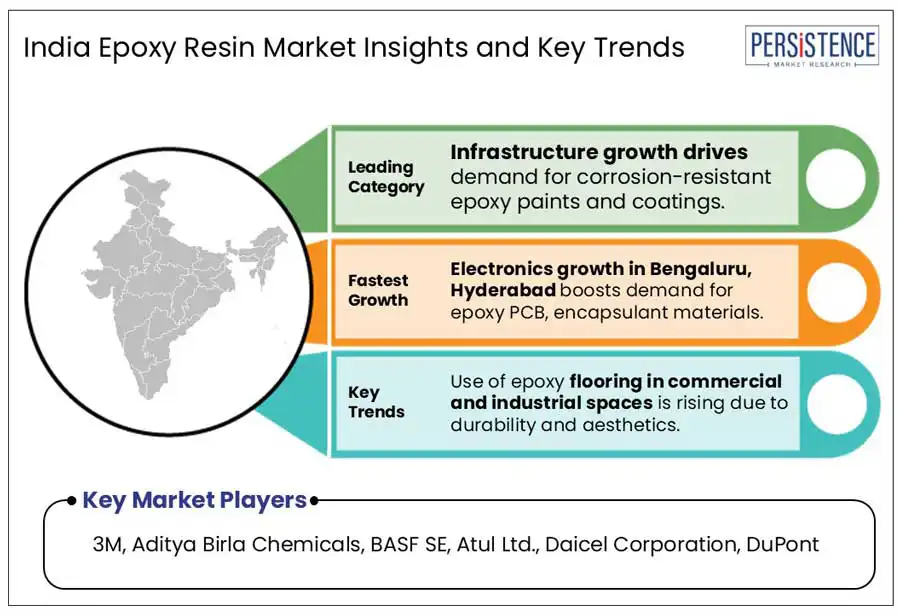ID: PMRREP35279| 170 Pages | 6 May 2025 | Format: PDF, Excel, PPT* | Chemicals and Materials

The India epoxy resin market size is predicted to reach US$ 1,120.7 Mn in 2032 from US$ 730.7 Mn in 2025. It will likely witness a CAGR of around 6.3% in the forecast period between 2025 and 2032.
India is estimated to see steady growth in the foreseeable future due to ongoing infrastructure development plans and implementation of favorable industrial policies. The government’s target to achieve US$ 1 Tn in manufactured products exports, rolled out in August 2021, has already created a strong framework for the growth of the manufacturing sector. This goal has specifically benefited epoxy resins companies with high demand from a wide range of end-use industries.

Key Industry Highlights
|
Market Attribute |
Key Insights |
|
India Epoxy Resin Market Size (2025E) |
US$ 730.7 Mn |
|
Market Value Forecast (2032F) |
US$ 1,120.7 Mn |
|
Projected Growth (CAGR 2025 to 2032) |
6.3% |
|
Historical Market Growth (CAGR 2019 to 2024) |
5.7% |
Ongoing development of the renewable energy sector is expected to propel the India epoxy resin market growth through 2032. Epoxy resins are considered significant for the production of wind turbine blades. This is due to their superior dimensional stability, corrosion resistance, and mechanical strength. Rising investments in wind energy development projects across the country are predicted to augment demand.
The country’s wind energy capacity experienced a steady surge in 2024, with India adding 3.42 GW (gigawatt), bringing the total to 48.16 GW. This is attributed to constant efforts of state distribution firms to meet the renewable purchase obligations. Tamil Nadu, Karnataka, and Gujarat, for example, accounted for nearly 98% of the new wind capacity installed in 2024. Hence, the surging focus on wind energy will likely boost epoxy resin demand in this sector.
A gradual shift of consumers toward low-volatile organic compound (VOC) and zero-VOC products is speculated to hamper epoxy resin sales to a certain extent. This is particularly evident in the chemical industry, where regulatory pressures and environmental concerns are compelling both manufacturers and consumers to adopt more sustainable alternatives.
The Government of India has implemented stringent norms revolving around the usage of toxic chemicals, including bisphenol A (BPA). It is considered a significant component in conventional epoxy resins. The move toward lowering VOCs and other hazardous emissions has resulted in a high demand for alternatives across industries. Sectors such as construction and automotive, for instance, are increasingly adopting low-VOC and waterborne epoxy formulations. However, even though these are eco-friendly, their high costs are anticipated to deter price-sensitive consumers.
Epoxy resin manufacturers are poised to bag new opportunities from the medical device sector in India. The chemical is extensively being used in medical device manufacturing, backed by their ability to form precise components, high chemical resistance, and mechanical properties. It is mainly valued in implants and prosthetics as these require high strength and biocompatibility.
The versatility of epoxy resins further allows for the development of customized solutions catering to specific medical applications. Innovations such as bio-based epoxy resins and those with improved biocompatibility are being investigated to fulfill the evolving demands of the medical device industry. This is anticipated to create lucrative opportunities for research and development activities, enabling companies to differentiate their products in a competitive market.
Based on raw material, the market is divided into DGEBA, DGBEF, novolac, aliphatic, and glycidylamine. Among these, the DGEBA segment is poised to account for a share of around 66.2% in 2025. This is attributed to its increasing use across several industries and versatile properties. DGEBA is extensively used in the manufacturing of composites, adhesives, coatings, and paints, especially for industrial and construction applications. These are highly preferred for their superior adhesion capabilities, chemical resistance, and mechanical properties.
DGBEF, on the other hand, will likely experience steady growth through 2032, due to its surging use in applications requiring improved chemical resistance and lower viscosity. Novolac resins have also found usage in high-temperature environments and applications requiring superior chemical resistance. Aliphatic resins are further estimated to find use in settings requiring high UV stability and weather resistance. Lastly, glycidylamine resins are speculated to be used in the aerospace and defense sector owing to their high temperature resistance.
In terms of application, the market is segregated into paints and coatings, composites, adhesives and sealants, and electrical and electronics. Out of these, paints and coatings are projected to lead with 54.7% of India epoxy resin market share in 2025. This is attributed to increasing use of epoxy resin-based formulations in multiple coating applications, right from decorative paints to protective industrial coatings. Growth of the segment is also spurred by the booming construction industry of India with increasing smart city projects initiated by the government.
The composites segment is poised to showcase a significant CAGR through 2032, owing to rising adoption in the aerospace and defense sector as well as energy installations. The electrical and electronics segment is also expected to exhibit decent growth, on the back of the rising electronics manufacturing ecosystem in the country. It is mainly supported by initiatives such as the Production Linked Incentive (PLI) scheme and Digital India.

West India is considered a key hub for various industries that are leading consumers of epoxy resins. For example, Maharashtra is a significant industrial hub of West India, with cities, including Pune and Mumbai housing several electronics companies, automakers, and manufacturing plants. The automotive industry in Maharashtra has witnessed a notable surge in epoxy resin demand, as these are considered integral in automotive adhesives and coatings.
The automotive industry witnessed a production increase of 4% year-on-year in Maharashtra in 2024 alone, thereby bolstering demand for epoxy resin-based solutions. Gujarat, on the other hand, is speculated to see steady growth with the presence of a well-established chemical manufacturing infrastructure. Epoxy resins are being used for laminates, adhesives, and coatings in the state, specifically in the electronics, construction, and petrochemical industries.
In North India, states such as Uttar Pradesh and Haryana are expected to remain at the forefront of growth due to the presence of large-scale automotive manufacturing units. Maruti Suzuki, one of the most significant vehicle manufacturers in India, has a production facility in Haryana, contributing to the increasing demand for epoxy resins. Automotive production in the state rose by 6% in 2024, bolstering demand for these chemicals as they are used in high-performance coatings for corrosion resistance.
In Lucknow, Chandigarh, and Delhi, ongoing infrastructure development activities are predicted to create a high demand for epoxy resins. For instance, Delhi’s metro expansion plan, which aims to add more than 100 kilometers of tracks by 2025, is constantly pushing demand. Epoxy resins are being used in protective treatments, coatings, and flooring across these projects as they are exposed to extreme weather conditions and high traffic.
South India is assessed to generate a share of nearly 32.1% in 2025. States in this region, especially Andhra Pradesh and Tamil Nadu, have showed steady growth in the renewable energy sector. Tamil Nadu, for example, has become a significant state for wind energy, contributing to more than 15% of India’s total wind power capacity. The high durability and strength of epoxy resins have made these ideal for the manufacturing of wind turbine blades.
Ongoing development of the electronics and electrical sectors in cities, such as Hyderabad and Bengaluru, is further anticipated to create new opportunities in South India. Epoxy resins are considered important for the manufacturing of encapsulants and Printed Circuit Boards (PCBs) owing to their superior electrical insulation properties. In addition, the rising demand for automotive electronics, telecommunications, and consumer electronics is estimated to spur epoxy resin sales.
The India epoxy resin market houses both international and domestic companies competing for high shares. Leading companies are focusing on innovating existing product portfolios with new research and development facilities. They are mainly planning to develop bio-based and sustainable epoxy solutions for a wide range of industries. Some of the other companies are embracing the collaboration strategy to co-develop new products in the market. A few renowned players are investing huge sums in the development of new manufacturing facilities across India.
The India epoxy resin market is projected to reach US$ 730.7 Mn in 2025.
Increasing production of wind turbine blades and the implementation of favorable industrial policies are the key market drivers.
The market is poised to witness a CAGR of 6.3% from 2025 to 2032.
Surging investments in public transportation network upgradation and increasing production of medical devices are the key market opportunities.
3M, Aditya Birla Chemicals, and BASF SE are a few key market players.
|
Report Attribute |
Details |
|
Historical Data/Actuals |
2019 - 2024 |
|
Forecast Period |
2025 - 2032 |
|
Market Analysis Units |
Value: US$ Bn/Mn, Volume: As Applicable |
|
Geographical Coverage |
|
|
Segmental Coverage |
|
|
Competitive Analysis |
|
|
Report Highlights |
|
|
Customization and Pricing |
Available upon request |
By Raw Material
By Application
By Region
Delivery Timelines
For more information on this report and its delivery timelines please get in touch with our sales team.
About Author